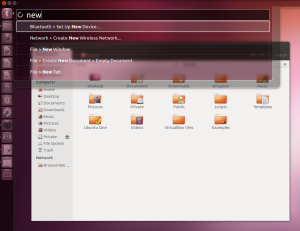2012-07-29
Openness has little to do with it
2012-07-07
A week in Ubuntu: The good, the bad and the ugly
2011-04-11
Natty Not-quite
- The dock is unwieldy if you have a lot of applications. I either have to scroll ( really slowly ) or drag vertically which is clunky at best with a mouse.
- The dock is a little too twitchy and none of the behavior options feel right. There's something annoying about having to go to the top to activate it. I have to direct my mouse a bit more than i'm used to. OSX and KDE this fantastically, the dock is always ready and pops up when you need it to. Windows still has an issue - since '98 - where it sometimes doesn't focus are refuses to pop up.
- The unified menu bar forces extra clicks. I hate it in OSX, and hate it here. I often have multiple windows open, and sometimes am mentally focusing on a background window. This may be that the foreground window is a popup or something insignificant to me. I always have to do a double take when i see the wrong menu bar. This may not make sense to some people, but i often operate with 2 screens or with small overlays and the 'foremost' app might not be immediately obvious. In which case the menu bar becomes non-obvious. I want an option to en/disable it like in old-school KDE ( remember those days? ).
- If i have 2 windows of the same app open, there's no easy way to access either with one click. This happens a lot in apps like Empathy and Chrome. I first have to pull out the unwieldy dock, then click on Chrome - which i see has 2 little arrows. Then it zooms out and presents me with 2 thumbs of my windows. That's great and all, though a little hard to see with fullscreen apps. My suggestion here would be to look at Windows 7 as an example of the new wave of app management done right. Hover over the taskbar item, get presented with thumbs. Hover over the thumb, bringing the hovered window to the front. At first i hated the step toward the OSX style there, but i quickly realised that they made it work. Unity has basically knocked off OSX.
2011-02-27
Emergence of the Tablets
2011-01-01
Lucid Nexus One Development
- You have to keep redoing it every time you start up your dev environment
- Running a potentially insecure service as root!!!
- If you do restart it while eclipse is running, you get some extra output in the console window
- Unplug your device!
- Create a file as root: /etc/udev/rules.d/51-android.rules
- Paste this line into the file: SUBSYSTEM=="usb", SYSFS{idVendor}=="XXXX", MODE="0666"
- Lookup the vendor id in this table ( from the android dev site linked above ) and replace XXXX with your devices vendor id:
If you're using a Nexus One, like myself, the vendor id is NOT in that table! At least for some reason, my vendor id registers as: 18d1Manufacturer USB Vendor ID Acer 0502Dell 413cFoxconn 0489Garmin-Asus 091EHTC 0bb4Huawei 12d1Kyocera 0482LG 1004Motorola 22b8Nvidia 0955Pantech 10A9Samsung 04e8Sharp 04ddSony Ericsson 0fceZTE 19D2 - Save and close the file. Plug in your dev device, and start up eclipse/adb.
2010-12-05
Trying to go back
2010-01-24
Intruder alert
Otherwise, i have done some testing of Motion Detection software for Linux, and here is a brief overview of what i have discovered.
There appear to be 2 developed solutions, ZoneMinder and Motion.
ZoneMinder:
This seems to be the more well known and more established of the 2. It appears to have lots of binaries available, but sadly mostly for debian based platforms. If you need to compile it from source, it becomes a complete nightmare of weird dependencies, many of which i didn't know existed. It took several hours to get configure to run, and in the end, i could compile it, but it crashed on launch. Not very impressed. I also noticed that it was heavily perl based, and while i have no problem with that, it did make things more complicated than they could have been. That said, the screenshots show some fantastic features, and i'm sure that if you can get it up and running, it's a great - although possibly overcomplicated - piece of software.
Motion:
This also had a few odd dependencies, but took no more than an hour from download to simple motion snapshots working. After working out how to set up the config file, i also got the built in webserver running. From here, i need to set up a remote viewing and config site and an email notification service, which shouldn't be too hard. Overall, this software is considerably easier to setup than ZoneMinder however not as feature packed. This does, however, do everything i need it to do, and has some nice extra features which i thought i might have to build myself. It may be simpler than ZoneMinder, but it is definitely extensible. It also includes setup for proper LAN security cameras and the built in webserver has some nice features. There are also some smart features such as automatically drawing a white box around the area of motion in the image.
Conclusion:
If you just want to set up a simple motion detection camera for home, i recommend Motion, as the setup was simpler, and it does the basics really well. If you need a bigger solution, and potentially have a PC to spare just for this purpose, then ZoneMinder is probably what you want. In the end, i'm just really glad to see some motion detection solutions for Linux.




